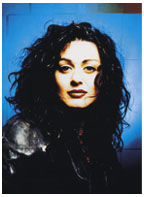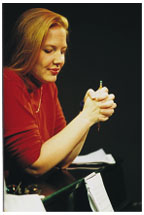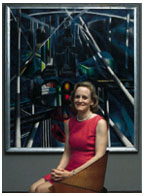December 5, 2001: Features
Creative
license
Alumni follow their talents into the arts
By Kathryn Federici Greenwood
For a school known for its theoretical approach to acquiring knowledge, Princeton has proven to be a fertile learning ground for the hands-on work of artists-in-training. Undergraduates learn how to take center stage, hone their instrumental and vocal skills, and engage in the visual arts, including drawing, painting, and sculpture. The alumnus and three alumnae interviewed for this story dove deeper into their artistic arenas on Princeton’s campus. And as most of them have shaped their careers, they have defined their own goals, with no set path to follow. Along the way, each has realized that they are telling stories — whether through body movements, lyrics and sounds, characters and plots, or paintings and sculptures — making something new along the way.
 Finding
the heart of ballet
Finding
the heart of ballet
José Mateo ’74
To José Mateo ’74, a dancer and choreographer, ballet is not about getting the poses right.
The founder and artistic director of José Mateo’s Ballet Theatre, a school and performing company in Cambridge, Massachusetts, he wants his students to understand “that the study of ballet can be a path of self-discovery” and that the body is their instrument. And Mateo loves watching them “shift their attention from imitating the outward poses or positions of ballet and turning their attention instead to observing their instrument as it executes these positions.”
People who work for Mateo say he’s demanding, but he also has a gentle and kind presence. He speaks softly when he teaches the dancers in his company, showing them what to do with his own lithe body, wearing sneakers and baggy pants. His 25-member company, the second largest one in New England, puts on about four performances a year, drawing on his original choreographic works as well as new interpretations of classical ballets. His faculty teach students of all ages and ranges, from young children to adults.
One of the company dancers, Kim Carnevale, says Mateo shows the dancers a new step and then lets them explore that step for themselves. “He waits for the movement to develop on its own,” she says.
Music and dance have been a part of Mateo’s life since he was a little boy in his native Cuba. And when his family moved to the South Bronx in the mid-1950s, they never let go of those art forms. An art history major, Mateo received his first formal training in dance and choreography in Ze’eva Cohen’s classes at Princeton. After graduating, he moved to New York.
While dancing with several ballet companies, he recognized that there was a lot about classical ballet that he didn’t like. “Ballet seemed pretentious, artificial, arrogant, strained,” says Mateo, whose parents were laborers in the U.S. and never attended college. He developed a new vision of contemporary ballet — New Classicism — that retains the classical principles of the art form, but discards the pomp and excess of traditional ballet. “It’s a more naturalistic style,” says Mateo.
Mateo’s choreography has been called “still water that runs deep,” and “Balanchine with a heart.” He’s drawn, he says, to music “of the great masters, ranging in compositional styles from the Baroque to 20th-century Romanticism, from Mozart to Stravinsky.”
While most dancers practice in sterile, box-shaped studios, Mateo’s company trains and performs in the innards of a national historic landmark, the Old Cambridge Baptist Church in Harvard Square, complete with peeling plaster, stained-glass windows, and unobstructed space — an environment that inspires movement. People in the audience sit in the bays at the sides of the nave and watch the dancers from unconventional angles.
Mateo is trying to make ballet more accessible to people of all ages, through the cost of tickets, through scholarships to the school, and through the performances themselves. He wants to help people understand that “ballet is not merely entertainment, but has a great potential to move the spirit and stimulate the intellect.”
“His Nutcracker is not so fancy, so glitzy, so rich that it will alienate people from less privileged backgrounds,” says Cohen. Yet its execution “is of the highest artistic and technical standard. Usually ballet belongs with the richest people in this country. He’s not going for that. He’s going for grass roots.”
 Creating
music any way she can
Creating
music any way she can
Deborah Hurwitz ’89
A musical artist who has an appendage in every aspect of the industry, Deborah Hurwitz ’89 has donned glitter eye shadow and vinyl pants on tour with Cyndi Lauper and Cher, played keyboard for and conducted Broadway shows, and composed and produced music for film scores, TV shows, and commercials. She’s as comfortable performing in front of audiences as she is working behind the scenes in a studio, making innovative musical sounds.
If she had to fill out a job application, her title would read: composer, songwriter, conductor, arranger, pianist, and singer. “I’d like to think of myself as a Renaissance woman, but you could also call it jack-of-all-trades,” says Hurwitz.
She recently returned from a year-long gig as associate music director and keyboardist for the national tour of Mamma Mia!, the new musical based on the songs of ABBA. Now back in Manhattan, she’s resurrecting her studio in the living room of her one-bedroom apartment and resuming projects.
A piano prodigy, Hurwitz, who was born in Harrogate, England, has been making music since her parents bought her a small electric organ at age four. She made a major solo piano debut at age 12, but as a teenager became more interested in singing, songwriting, and pop music. And at Princeton, where she majored in music theory and composition, she discovered the joys of electronic music production in the Woolworth studios on campus.
Often Hurwitz sees her role as the person who builds a “bridge between the technology world and the live-performance/unplugged/purist world. I’ll bring a sound to a piece of music that’s a little more produced, a little more polished.” In the studio using recording equipment, including keyboards, synthesizers, mixing consoles, and outboard effects, she can create “a certain kind of sound of music that you just can’t get live.”
When she’s composing a film score, she develops a dominant theme so that all the music segments in the film work together. “My goal is to come up with a piece of music that by itself sounds great — has motion, has form, has musical coherence. And then when you put it up against the picture — disappears. And does everything it should do to bring you emotionally where you need to go and accompany and color and bring to life the picture.”
In addition to her studio and theater work, Hurwitz has taken on “that whole solo artist thing” as a singer/songwriter under the name Deborah Marlowe — whose music has been described as a rich blend of pop, acoustic rock, and electronica. She’s working on her second CD. Writing the lyrics for Deborah Marlowe songs can be therapeutic, Hurwitz says. “When something is really eating at me, instead of talking to myself or venting, I will try to crystallize it into a piece that puts it outside of myself. I know that I’m done and it’s right when it makes me cry or I go, ‘Yes, that’s it!’ . . . I feel relieved. I feel done. It takes it out of me.”
Gutsy and at times outrageous, Hurwitz took it all off last year at a week-long festival in the Nevada desert called Burning Man, which attracts thousands of artists and hippie types. While conducting a 600-person nude opera, she wore only body paint, a black thong, huge red feathers on her arms, and spiky red heels. “That’s the kind of thing I love being able to do. My life is flexible enough, and I’m still kind of out there enough even though I’m 33. Something like that can feel wonderful and fresh.”
 Trying
to make it in New York theater
Trying
to make it in New York theater
Cara Reichel ’96
From the cramped Manhattan apartment that serves as her office, Cara Reichel ’96 is making a go of it in the competitive world of small theater in New York. Along with four Princeton friends, Reichel founded Prospect Theater Company three years ago and to date has produced four shows in New York and two summer theater programs in Georgia.
Reichel and her cofounders — Melissa Huber ’96, Tony Vallés ’97, Charles Perkins ’96, and her boyfriend and roommate Peter Mills ’95 — started working together through student-run performance groups on campus, including Princeton University Players and the Triangle Club. After graduation and a couple of years of getting “little assistant-type theater jobs around the city,” Reichel missed working hands-on in theater with her Princeton pals. So she called them up.
When they started the company, “We really didn’t have any money,” says Reichel, whose living-room table is a Princeton-issued acting cube used on stage sets. The founders have lent the company money and split the losses when necessary. They all have other part-time or full-time jobs. They re-hearse anywhere they can find a space for free or at a good rate.
They started small in March of 1999, with a one-weekend run of the medieval morality play Everyman, which Reichel adapted and directed. Since then, the company has produced The Taxi Cabaret, an original musical revue about six young people trying to make it in New York City; The Flood, based on field research Reichel conducted as an undergraduate after the devastating 1993 floods along the Mississippi River; and an outdoor production of Shakespeare’s Twelfth Night in Central Park.
As Prospect’s artistic director and producer, Reichel often is the one who comes up with new ideas for shows. She will noodle on a rough sketch for the plot and characters and an idea for a song or a scene. And she and Mills will think about “the story we want to tell.” Then Mills, a lyricist, composer, and music director, further defines the story and characters. “His passion and his craft are really in the writing of the music and the lyrics,” says Reichel. “He’s very good at taking rough ideas and making them into something witty and moving and wonderful.”
Now Reichel is gearing up for Prospect’s biggest challenge to date, producing its first full season of shows in New York: two plays, Danton’s Death and Three Sisters, a new musical, Illyria, by Reichel and Mills based on Twelfth Night, and some one-act shows. To make that happen, the company needs to raise upward of $50,000, so she’s busy writing grants and raising funds.
Tying all the company’s projects together is a look at the intersection of performance and culture. “A big part of our mission is to use theater to explore cultural differences,” explains Reichel, who majored in anthropology and is finishing up her M.F.A. in directing at Brooklyn College. “That is the thing that excites me about theater — what it has to tell us about ourselves and about who we are and what we could be. . . . Theater never lets you sit back and be complacent.”
 Telling
stories with works of art
Telling
stories with works of art
Elliot Davis ’84
Elliot Davis ’84 is surrounded by beautiful things: paintings by Mary Cassatt and John Singer Sargent, silver by Paul Revere. And it’s her job as chair of the Art of the Americas department at the Museum of Fine Arts in Boston to determine the best way to display them. In doing so, she asks herself, “What is the story we’re trying to tell?”
“Curators are taught to see the complexity and many meanings of works of art,” says Davis, who immerses herself in the culture, history, politics, and music as well as the art of a particular period of time when she’s planning a new exhibit or gallery. But a curator has to get at the “most essential” meanings. “You have to be realistic about what people can absorb,” she says. Each gallery, she says, should have only one or two major themes.
An art and archaeology major at Princeton and an authority on 19th- and 20th-century prints and drawings, Davis came to the Museum of Fine Arts from New York’s Metropolitan Museum of Art last winter to oversee the planning of a new American wing that may be erected by 2007. Excited by the prospect of taking a fresh look at American art, Davis is thinking about how she can create a whole new experience for visitors.
Art and museums run through Davis’s veins. Her mother, who died at age 31 of an aneurysm when Davis was four, was a painter and printmaker in Manhattan and a member of the board of the Art Students League, and her grandmother worked in pastels and watercolors. Davis spent a lot of time in her grandmother’s studio, where she experimented with charcoal, graphite, Conté crayons, pastels, and watercolors to “see how they behaved” on paper. She also studied life drawing and printmaking.
She learned about museums through her great-grandmother, who founded the Shelburne Museum in Vermont, which has 37 buildings on 45 acres, featuring primarily American folk art. And she liked poking around antique stores and auctions with her father, a physician in Manhattan, and her three siblings. “He would pick some unusual object such as sugar tongs and ask us, ‘What was this used for?’ If you guessed first you got a quarter.”
Davis, who earned a Ph.D. in art history and archaeology at Columbia, has been interested in both European and American art but finds herself returning to the latter, which she says is sometimes sneered at even in academic circles for being inferior to European art.
“There have been great
works of art created in the U.S. and sometimes under great duress. We
didn’t have the same level of training at our fingertips that Europeans
had. We didn’t have the same kind of support system in terms of royal
patronage. Artists had a real row to hoe here. It was a struggle. And
they overcame it and that’s what we hope will be one of the great
stories of this new American wing.” ![]()
Kathryn Federici Greenwood is PAW’s staff writer.
On the Web:
www.ballettheatre.org, www.hurwitzmusic.com;
prospecttheater.org; www.mfa.org
